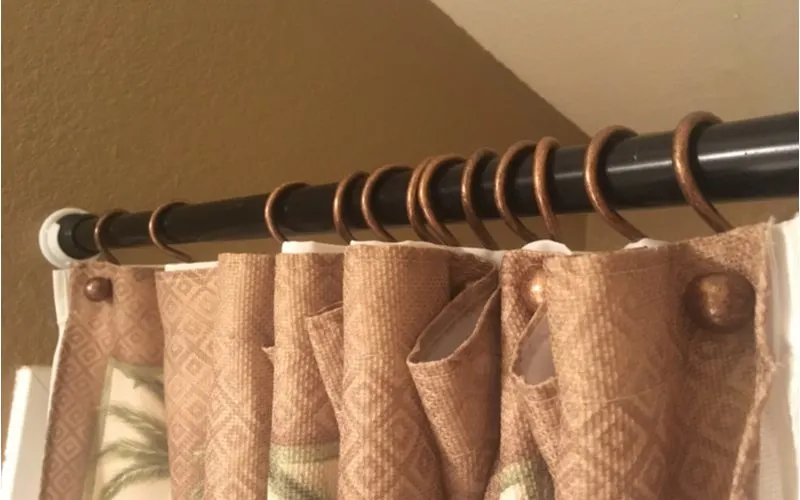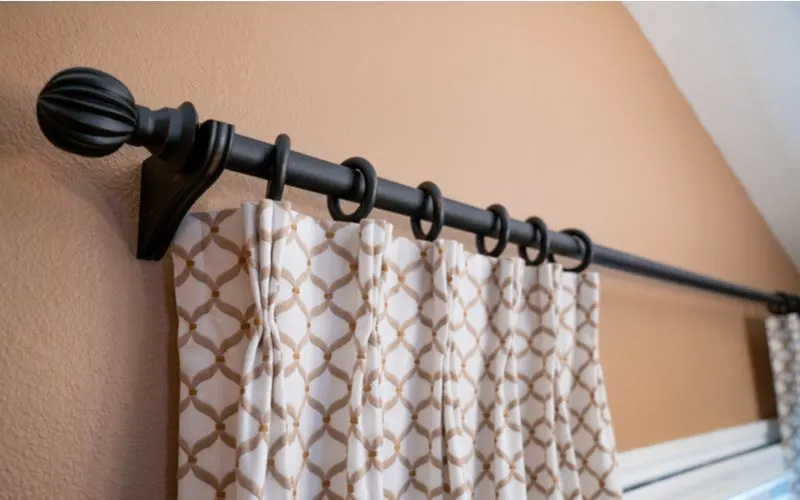How much weight can a tension rod hold? Are there specific places I should install one?
What about places to avoid? If you’re asking these questions, you’re in the right place. Read on to learn all you need to know.
The Quick Answer
So, how much weight can a tension rod hold?
You probably don’t spend much time thinking about tension rods, but you’ll need to give them some thought if you plan on sprucing up your curtains.
Tension rods don’t have the carrying capacity of most supportive rods. They can only carry about 20 pounds, but that should hold most curtains.
How Much Can a Tension Rod Hold?

Thanatos Media/Shutterstock
A tension rod works by pressing against two walls, relying on tensile strength to keep it in place. They are spring-loaded to help them extend and contract between the walls.
Tension rods have a metal, wood, or plastic construction. You can place them on your walls without drilling them in, making them useful for renters looking to keep their security deposit.
Also, you can readily install them anywhere in your house. They are affordable and widely available. Due to their low-maintenance anchoring, they lack the support of more secure curtain rods.
However, the different materials used determine the load you can put on the rod without it falling. Keep reading to learn more about how much weight a tension rod can hold.
Aluminum Tension Rod
The most popular tension rod has an aluminum composition. People typically use aluminum rods to hold shower curtains and lightweight clothes. Aluminum is a low-density metal with moderate strength.
It resists corrosion well, making it ideal for wet areas like showers. Your standard aluminum rod can handle about 20 pounds.
Most manufacturers make them between 58 and 72 inches long, but you can find them in other sizes.
Steel Tension Rod
Stainless steel tension rods are practical for heavy-duty applications. They are on the pricier side, but they cover most of your holding needs.
These big boys can handle up to 45 pounds, making them perfect for winter closets and thick curtains.
Stainless steel is composed of iron, carbon, chromium, silicon, nickel, sulfur, phosphorus, and manganese.
Its density is over twice that of aluminum, and it has a high yield tensile strength of 31,200 psi. It takes a lot of weight to break stainless steel.
Since stainless steel rods can get costly, you should reserve them for heavyweight applications. If you only need to hold something light, look for one of the cheaper options.
Spring Tension Rod
Spring tension rods are cheap yet weak. You can find them in plastic or metal, and they usually hold a maximum of 10-15 pounds.
These rods feature two rods with capped ends. The smaller rod holds the larger one in place by compressing an internal spring.
They are often adjustable between 28 and 48 inches. Because of their low weight capacity, you can typically only use spring tension rods for blinds and shower stalls.
If you’re on a budget or only need to hold something light, you can use spring rods without a problem.
Heavy-Duty Aluminum Tension Rod
Heavy-duty aluminum tension rods use a higher-density aluminum alloy than the standard ones, increasing the load they can hold.
They often come with a non-slip tension lock that keeps them in place, even with a weight on the higher end of their range.
Heavy-duty rods can hold around 30 pounds, but the weight capacity will vary depending on the alloy used.
Usually, the manufacturer will dope the aluminum with copper, silicon, magnesium, or manganese to improve its strength.
Their higher capacities make them useful in closets, as they can hold most of your clothes. They are more affordable than stainless steel, so they’re a good choice if you don’t need to hang up ten winter coats.
What Can You Put on a Tension Rod?
Tension rods are versatile devices that can hold up many items in your home. You can put them on your windowsill to hang blinds or install one in your bathroom for a shower curtain.
If you need to air dry a dress or prevent something from getting wrinkled, you can hang one up in a door frame.
Children’s closets can get away with a spring or aluminum tension rod, but an adult’s will need the heavy-duty or stainless steel type.
You can divide a room for privacy using a longer tension rod. If you’re feeling creative, you can hang up house plants on a heavyweight option to support your indoor garden.
Frequently Asked Questions

Magargee Films/Shutterstock
Here are some common questions concerning the efficacy of tension rods.
Do Tension Rods Work?
Tension rods work to hold up various items in your home. You can use them for a range of light or heavyweight applications, depending on the material used.
Make sure you choose the right size for your wall. You want it to be larger than the distance between the two walls to allow the springs to compress.
How Do I Keep My Tension Rods From Falling Down?
You can keep tension rods from falling by getting correctly sized rods. Also, you can buy one with a larger carrying capacity than your intended application.
Look for one with a lock as well. These tips will help you secure it in place without falling.
We highly suggest using these, even if you might have to spend more money than you intended for extra security.
If you are on a tight budget, you will have to place fewer items on it than you may want to ensure it stays upright.
Will Tension Rods Affect Walls?
The rubber cap on a tension rod can remove paint from the walls. You can protect your walls by applying felt pads to the ends. Also, you can choose a paint coat with a satin or semi-gloss finish.
This helps to create a hard surface. Make sure you wait one week for the paint to dry before installing your tension rod as well.
So, How Much Weight Can a Tension Rod Hold?
A tension rod can hold between 10 and 45 pounds, depending on its material.
However, the average tension rod can handle about 20 pounds. Whether you want to suspend curtains or clothes, a tension rod makes an excellent addition to your home.

